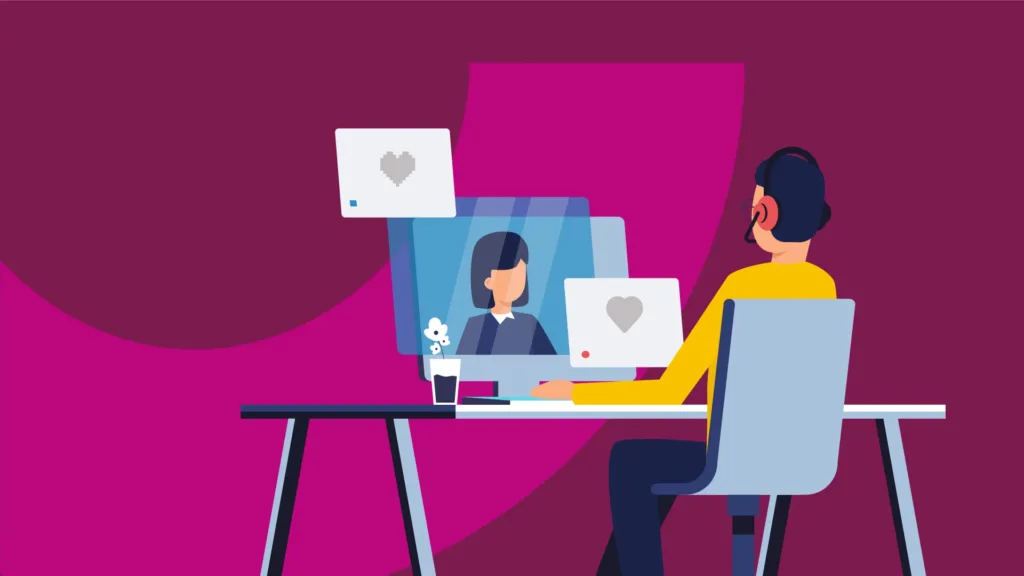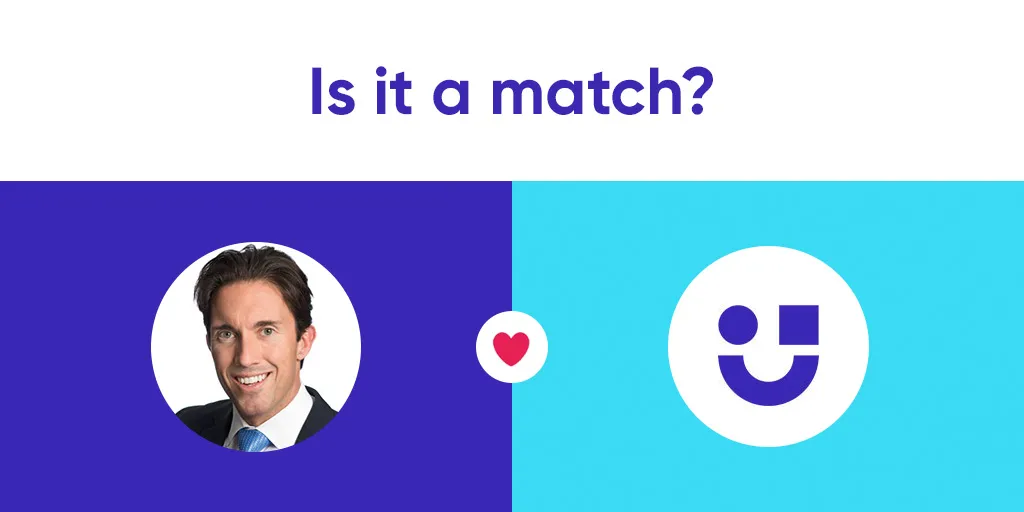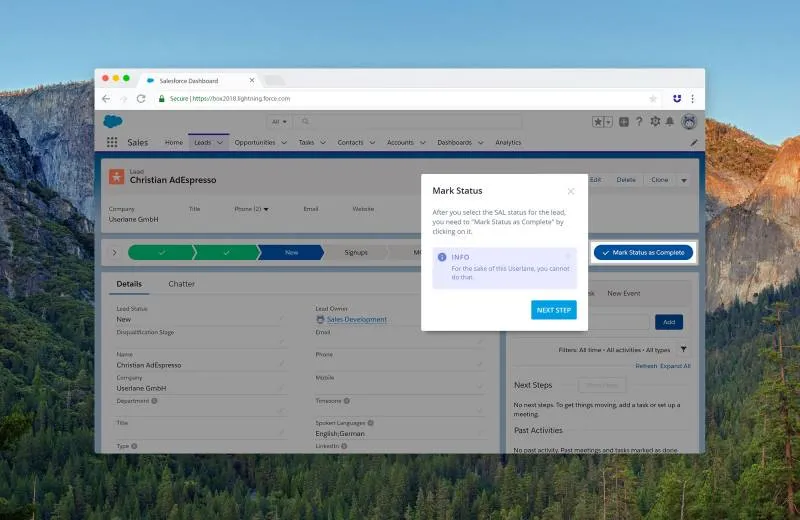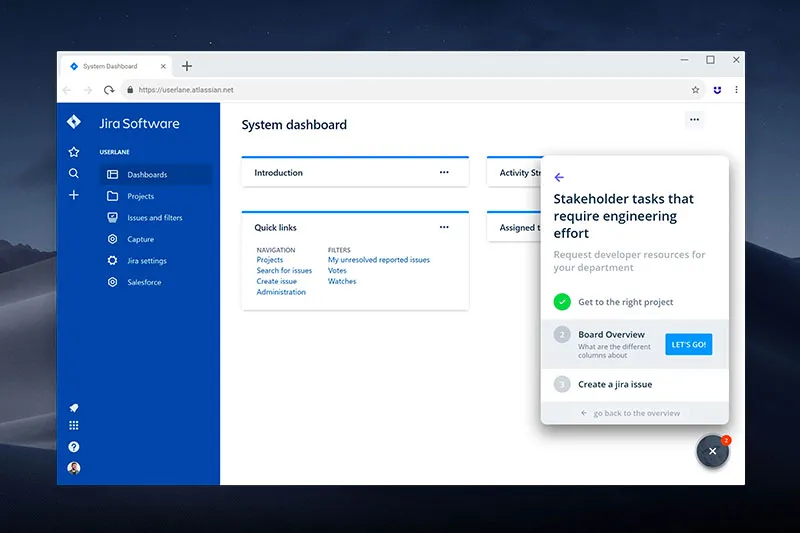The Most Romantic Love Story in Tech Two Years Later

Two years ago we went through a major rebranding. We launched a new logo, a new website, and a new message together with a newer and more powerful version of our editor for software guides.
At that time, we were already aware of the fact that the role of interactive guidance was bridging the knowledge gap between humans and machines and that our software had been developed to allow anybody to use any software without formal training from the get-go.
We published our new site on Valentine’s day 2016. And the date made perfect sense!
Because that’s when we introduced Hannah and Felix and told the most romantic love story in tech.
I’m sure you remember them. Felix is the emotional character in the story while Hanna is a more rational and analytical character. The two of them need each other, but they have a hard time when it comes to communicating with each other since they speak a very different language and approach problems from a completely different point of view.
Felix can’t live without Hannah and Hannah can’t live without Felix, but, in the beginning, their relationship seemed impossible. Until they discovered a friend. Someone who was there to help them communicate with each other. Someone who was able to eliminate every obstacle and allow Felix and Hannah to successfully and effortlessly interact with each other.
The whole story was a metaphor. It was meant to represent the strenuous relationship between humans and machines and the role of Userlane.
At that time, we created Tinder-like tweets with pictures of influencers and our new logo, and we asked them if they liked our new brand image.

A lot of people we addressed and tagged on Twitter replied with funny messages like, “swipe right” or, “It’s a match!”. The tweets also had a link to our new website where we placed a bar that asked, “Do you want to be our Valentine?”
When people clicked on the banner, cheerful music started and confetti filled the screen to celebrate the event.
Then, people were redirected to our article and they read all about Hannah and Felix and their impossible love together with all the messages hidden in our logo design, our mission, and new (at that time) corporate identity.
The campaign was quite successful. It was picked up by external publications that reported on the re-branding campaign.
From that day on, Valentine’s day has always been OUR holiday. Every year we celebrate our brand and our mission and the relationship between humans and machines. And we also celebrate Hannah and Felix!
However, the most important question now is: what happened to Hannah and Felix? What’s the status of their relationship two years later? Does Userlane still play a significant role as an interface between humans and machines? What stayed the same? What has changed?
Table of Contents
Important Disclaimer Before Digging In
Before we answer all the questions mentioned above, I need you to carefully read the following disclaimer.
The story of Hannah and Felix is just a metaphor. The story was purposefully misleading. We wanted people to assume we were talking about two individuals, who were actually going through a complicated romance, and to ensure readers would go through the entire story until they realized it was just a gimmick to introduce the relationship between people and software which Userlane mitigates and facilitates.
The story we created is not linked to genders or roles. The whole story goes beyond simplified stereotypes and inefficient definitions. It might as well have been the story between Steve and George, Kathleen and Barbara, Zurgoz and Pkork, or any other two individuals.

At that time, the name Felix came to mind because of two important people who played (and still play) a decisive role at Userlane, both named Felix. Hannah just came up because the character was supposed to be an extremely intelligent and clever individual. This description reminded us of Hannah Fry, British mathematician, author, speaker, and Youtube celebrity
The choice of their names was purely contingent and not related to any association with genders and roles.
In our story, neither humans nor machines actually have a gender!!!
In a minute, you’ll see why I need to emphasize this.
Humans and Machines Two Years Later
What has changed in the relationship between people and software and the role of electronic performance support in the past two years?
When Userlane was founded four years ago, it was clear that the world desperately needed us.
People were forced to interact with more and more applications both at work and in their personal lives. At the same time, it seemed as though software was becoming increasingly complicated day by day.
And now? What about software and usability in 2019?
I look at my team and see that we deal with something like 30 to 40 software solutions on a daily basis. We use software for project management, automation, communication, design, research, analysis, reporting, promotion, CRM, data collection, data visualization, time management and so much more…
Every action is connected to a specific cloud solution. Things have become even more “digital” over the past few years.
And that’s not only true for our company. Everyone I speak with reports on having a very similar experience.
And as far as usability is concerned, every application is completely different.
UX design is becoming one of the most important components in product development.
Over the past few years, user flows have become a lot more intuitive, and when it comes to creating user-friendly interfaces, many applications tap into a series of standard design elements (e.g. three dots to access options and properties, three lines for the menu….) to create a consistent and familiar experience across multiple platforms.

Nonetheless, the concept of intuitive interface still remains extremely subjective, and the ability to create a smooth UX with great product design still remains a myth.
There’s no objective yardstick that can be used to gauge user-friendliness for software as two different individuals will always perceive an interface in two very different ways based on their background and previous experience with other platforms.
Additionally, software applications are becoming more and more complex due to:
- Native Integrations
- Big Data
- API Integrations
- AI and ML
- Scope and Objectives
Software in the era of digital transformation needs to support a modern ecosystem that facilitates data collection and leads to the creation of a comprehensive overview of the entire customer journey.
Applications that myopically interact with a single stage of the customer journey without integration of other solutions don’t contribute to the goal of creating a consistent customer experience. They also don’t create data that can be used by cross-functional units at different stages.
That’s why, two years after our rebranding campaign, the relationship between humans and software needs to become stronger since interaction between users and software still represents a huge problem when it comes to speeding up roll-outs and software adoption.
People need software now more than ever to face the challenges created by digital transformation. And due to increasing complexity in the system, people, now more than ever, need support when dealing with software.
It’s All About People

We recently talked about the role of people in the era of digital disruption.
Meaningful experience focuses on the human experience, and it is people who determine the success of change management processes, not software.
We’ve established how important the relationship between people and software is.
We’ve also reached the conclusion that it’s impossible for people to interact seamlessly with every interface without support.
The relationship between humans and machines can be jeopardized by the fact that the two still speak a different language.
What software vendors and companies often do to sort out the issue is force people to learn how to interact with software.
But in the relationship between humans and machines, we take sides and firmly state that it’s not people who need to adapt to software but software that needs to adapt to people.
That’s why, now, two years after we presented our tech love story, we still believe that electronic performance support is the most suitable way to ensure a great human experience when it comes to interaction with software.
Today is the second anniversary of our new brand. Our mission still remains the same. But the rationale behind the big WHYs that determine our choices and corporate identity has been enriched through the interaction with our customers and the success of their software implementation.
Here’s a brief summary of what we’ve learned over the past two years.
Employee Experience and Digital Transformation
Companies should primarily focus on creating the perfect conditions that allow people to thrive and be successful. People are the faces and voices of a brand. They are the brains that shape visions and the hands that turn visions into actions.
There’s a reason why some teams are strong and others aren’t. And the reason is focus. Companies that invest in training people and supporting them when they work together always win. It’s all about people!
A great customer experience is the direct result of a great employee experience. Employees will treat customers the same way they feel treated.
Technology Should Serve People, Not the Other Way Around
We train people to learn how machines work. Why don’t we adapt machines to work with people?
We teach people how to interact with software, but it should actually be software that adapts to the way people work. Electronic performance support is a fundamental element of a healthy relationship between people and technology.

After all, we should never forget why we invented technology in the first place: technology is here to make our lives better. From arrowheads, to flint or quantum computers, tools have been created to overcome our human constraints (in terms of strength, speed, computation…) and serve our purposes. Technology needs to add value to our lives without creating friction, otherwise it defeats the whole purpose!
Digital Leaders Create Sustainable Ecosystems
Digital transformation requires humans and machines to work together seamlessly in order to create a smooth customer experience.
Digital leaders are those that realize that digitization is not about technology, it’s about people and a meaningful human experience.
Imbalance in the relationship between people and technology leads to instability and friction. The ecosystem created by companies that either focus exclusively on people or on modern technology is not sustainable in the long run.
Automation Means Optimization
We believe that there are certain tasks computers are best at and that there are tasks that only humans should attempt.
Automation is here to empower people to innovate and find time for those activities that actually matter – things only humans are good at.
Eliminating the need to learn how to interact with software means having more time to actually carry out tasks and bring ideas from inception to realization.
Between innovation and success, people are often hindered by the difficult task of implementing a strategy. The more time people spend trying to understand how tools work and how to get from A to B, the less time they have to figure out how to execute and deliver on such strategy.
The value of a book is pretty much zero if I don’t know how to read.
But imagine if we had to learn how to read from scratch every time we opened a new book.
That’s what usually happens with software. Everytime we start using a new piece of software, we find ourselves in an alien environment that we first need to familiarize ourselves with.

Interactive on-screen guidance is here to help people innovate without being forced to learn how software applications work.
Userlane allows people to focus on their goals instead of wasting time trying to understand how to get there.
Userlane Two Years Later
Over the past two years our company has grown exponentially. For people like me, who’ve been here since the very beginning, it’s hard to even see the legacy of the tiny startup we once were.
New people, new premises, better product…
And now, in 2019, we even have new colors and an upcoming brand new website.
However, our mission is still the same and we’re more convinced than ever that the world truly needs us to drive adoption and transformation.
Our core set of beliefs remains unchanged:
- Providing an Interactive Learning Experience instead of creating asynchronous theoretical content
- Focusing on Performance over content
- Providing On-Demand Meaningful Support for Users instead of only creating efficient processes for training content creators
- Being Engagement Driven instead of only focusing on compliance and attendance
- Creating Personalized Discovery Journeys over one-size-fits-all, prefabricated experiences
Two years might not seem like much in terms of sunsets and dawns. But in the digital era, two years represent a significant amount of time that could potentially transform the entire ecosystem with technological disruption.
Hannah and Felix still need each other, and they need Userlane to co-exist and communicate efficiently.
Their relationship has never been stronger, and we’re proud of the role we play in our customers’ successful implementation of modern and innovative digital strategies.
What will happen next?
Lots of things are about to change. And we’ve got tons of ideas that will make the relationship between people and software even more straightforward and natural.
I wish I could tell you more about it….but I guess we’ll have to wait one year when, on Valentine’s day, we’ll look back and talk about another year in the inimitable story of Hannah and Felix.
And speaking about meaningful innovation…we’d like to invite you to take part in our survey. It only takes two minutes.Three questions. No opt-in necessary to see the results.

